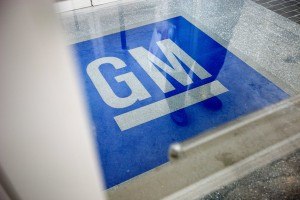

General Motors Co.’s self-driving unit is backing off plans to deploy robotaxis by the end of this year, the latest indication of how auto and tech companies are struggling with the challenges of taking humans out from behind the wheel.
While GM Cruise is accelerating efforts to get its autonomous Chevrolet Bolts ready, it’s not going to be able to validate their performance and safety in time for 2019, Chief Executive Officer Dan Ammann said in an interview and blog post. GM set that target a year and half ago, with Ammann — then the president of the automaker — saying they could “change the world.”
 GM shares slipped as much as 0.6% shortly after the start of regular trading Wednesday in New York. The stock is up about 21% this year.
GM shares slipped as much as 0.6% shortly after the start of regular trading Wednesday in New York. The stock is up about 21% this year.
GM Cruise is the latest company in the burgeoning autonomous-driving space, which has drawn billions in investment, to run into speed bumps. Alphabet Inc.’s Waymo planned to be the first to start a driverless ride-hailing service before the end of last year. But by the time the calendar flipped to 2019, it was only available to about 400 test families in suburban Phoenix, and its entire fleet of Chrysler minivans still had drivers behind the wheel.
Of course, the consequences of blowing deadlines pale in comparison to fatal crashes. An Uber Technologies Inc. test vehicle killed a pedestrian crossing the road in Arizona in March 2018, and at least three Tesla Inc. customers have died on U.S. roads while using its Autopilot system.
Robotaxis Are Still Coming
While Cruise won’t have robotaxis ready this year, its CEO says a public deployment isn’t far off. There’s “a clear line of sight” to getting regulatory approval and rolling out self-driving cars in San Francisco, he said in the interview.
To pull this off, Cruise is rapidly expanding testing in the city, building out its electric-car charging infrastructure to power the vehicles and working with government officials and the community to prepare for its robotaxi debut.
“There is a specific reason we are moving ahead with the next steps of scaling up infrastructure and scaling up tech,” Ammann said by phone. “Cruise cars are a very present thing and will be even more present. It’s going to be clear that we’re up to something, and that something is around the corner.”
With Cruise missing its goal, it’s becoming clearer that robocar software is a greater technological challenge than many had anticipated. When Volkswagen AG announced earlier this month that it would invest in and partner with Ford Motor Co.’s autonomous-car affiliate Argo AI, the latter was candid about how much work still remained.
“You see all kinds of crazy things on the road, and it turns out they’re not all that infrequent, but you have to be able to handle all of them,” Argo Chief Executive Officer Bryan Salesky said at the time, adding that scenes of driverless cars going anywhere are still “way in the future.”
In China, the world’s largest auto market, the man widely known as the father of the country’s electric-car industry recently voiced doubts about vehicles zipping around entirely on autopilot.
In his blog post, Ammann wrote that the stakes of safety are too high try out Cruise’s tech with the public and iterate the way tech companies might otherwise do with new software.
“When you’re working on the large-scale deployment of mission-critical safety systems, the mindset of ‘move fast and break things’ certainly doesn’t cut it,” Ammann wrote. “With such high stakes, our first deployment needs to be done right and we will only deploy when we can demonstrate that we will have a net-positive impact on safety on our roads.”
GM Cruise has raised $7.25 billion, with T. Rowe Price Associates Inc. being the latest to invest at a valuation that has steadily risen to $19 billion. SoftBank Group Corp.’s Vision Fund and Honda Motor Co. have also put money into the company, and GM Cruise now has about 1,500 employees. When its San Francisco fast-charging station is ready, it will be the largest in the U.S., Ammann said.
The first deployment of GM Cruise’s technology will be in a car similar to the electric Chevrolet Bolt that the company has been testing. In the future, there will be a new model, Amman wrote in the blog post. GM, Cruise and Honda engineers have been developing an electric vehicle designed for self-driving and ride-hailing services, he said.
Ammann said he’s being cautious about deploying the technology in cars on public roads, and making sure the public is ready. Any snafu could set back regulatory and public support.
“Society is looking for these advancements to be brought out in a different kind of way,” he said in the interview. “Underlying that is really this goal to gain wide-scale acceptance of the tech. To get full-scale buy-in, it’s really important that we do it the right way.”